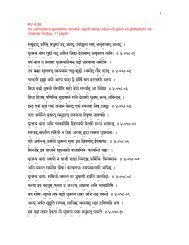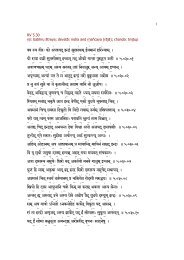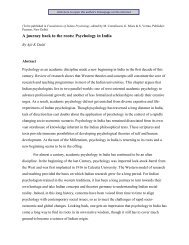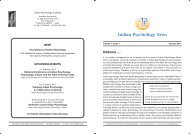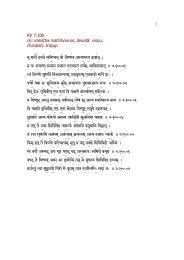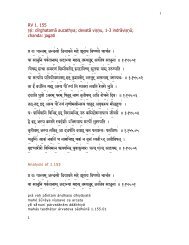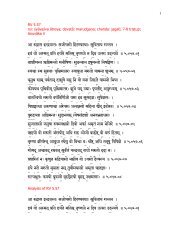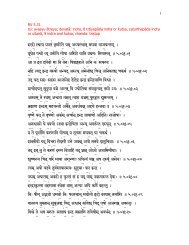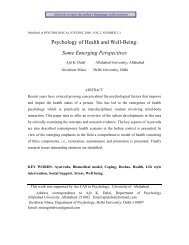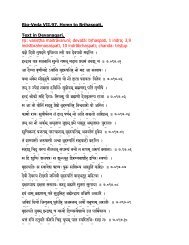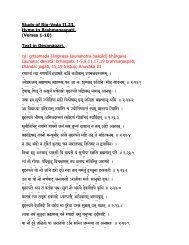core and Context -Fi.. - Indian Psychology Institute
core and Context -Fi.. - Indian Psychology Institute
core and Context -Fi.. - Indian Psychology Institute
You also want an ePaper? Increase the reach of your titles
YUMPU automatically turns print PDFs into web optimized ePapers that Google loves.
particular class, caste or creed, but people from all strata of the society can make themselves<br />
worthy of these pursuits (Radhakrishnan, 1953). Contrary to the misperception that<br />
traditional wisdom is accessible to men or Brahmins only, many women <strong>and</strong> non-Brahmins<br />
have attained the highest level of knowledge. The declaration „aham bramhāsmi‟ (I am<br />
brahman) is always followed by the phrase „tat tvam asi‟ (you are the same), which refers<br />
not only to all mankind but also to all living beings.<br />
Another important feature of IP is that it primarily deals with the inner states of a<br />
person, taking consciousness as the primary subject matter of study. Instead of emphasizing<br />
numerous contingent <strong>and</strong> non-contingent variations in acquired role-related behaviours the<br />
stress is on unchanging identity. In the Upanişads consciousness as a state of being is not an<br />
object but is conceived as undifferentiated subjectivity (Chit) without any content<br />
(Radhakrishnan, 1953). In the <strong>Indian</strong> tradition, consciousness happens to be the ground<br />
condition without which no reality is conceivable. It is the knowledge side of the universe,<br />
more than being a light source for apprehending sensations. The Ch<strong>and</strong>ogya Upanishad<br />
expounds four states of consciousness – waking, dream, deep sleep <strong>and</strong> turia (illumined),<br />
the most desirable one being the last one. When the mind withdraws itself from<br />
participation in sensory processes by deliberate intent <strong>and</strong> empties itself of all content, it<br />
would be the illumined state of consciousness. When this happens there arises unmediated<br />
direct knowledge, characterizing knowing by being (Rao, 2005). It involves identity with<br />
existence <strong>and</strong> its knowledge. As the Upanishadic saying goes, „to know Brahman is to be<br />
Brahman‟ (The Mundaka Upanishad III 3.2.9). Buddhism refers to the stream of<br />
consciousness as the basis of subjective feeling of continuity <strong>and</strong> identity which affects our<br />
perceptions, thoughts, actions <strong>and</strong> emotion. While formulating five modes of knowing in<br />
Buddhism the focus has been on inner transformation, with the ultimate goal being<br />
liberation (Premasiri, 2008). The five modes of knowing are: sensory, extra-sensory,<br />
holistic, insightful <strong>and</strong> ethical. According to Buddhism, the knowing should not be based on<br />
authority, faith, belief or speculation, but on personal experience.<br />
Sensory experiences leading to phenomenal awareness are intentional, that is, they<br />
are of objects. Distortions in this case are due to active interference of mind <strong>and</strong> body,<br />
which limits our awareness, <strong>and</strong> obscures our knowledge <strong>and</strong> feelings. The goal of life is to<br />
attain a state of pure consciousness where knowledge is direct, immediate <strong>and</strong> intuitive, <strong>and</strong><br />
not mediated by sensory inputs. Human consciousness is considered hierarchical, the highest<br />
state being that of truth, pure consciousness <strong>and</strong> bliss (Sat, Chit <strong>and</strong> An<strong>and</strong>). Yoga <strong>and</strong><br />
meditation are the processes for movement toward this transcendental state of pure<br />
consciousness. The engagement with pure consciousness makes IP transcendental in its<br />
orientation. Transcendence is a movement from mundane to sublime, from sensory to<br />
intuitive <strong>and</strong> from self (ego) to Self (enlightened). It is a psychological process of rising<br />
from narrow, personal reference of a problem that causes suffering to a transpersonal,<br />
holistic underst<strong>and</strong>ing, wherein the problem loses its sting. The transcendental view implies<br />
a position of self (ego) -decentering <strong>and</strong> taking into consideration the whole range of<br />
progression in past, present <strong>and</strong> future. It draws attention to non-egoistic <strong>and</strong> non-body<br />
centered encompassing vision of life <strong>and</strong> its processes. It enlarges or exp<strong>and</strong>s one‟s identity<br />
to incorporate others or anything or everything that exists (Self or all encompassing<br />
Brahman!). The Upanishadic Mahavakyas ( great sentences) like Aham Brahmasmi (I am<br />
Brahman) or Sarvam khalvidam Brahman (Everything is only Brahman) emphasize the<br />
value of ever exp<strong>and</strong>ing <strong>and</strong> inclusive identity. It sets the stage of an evolutionary journey in<br />
which the division of self <strong>and</strong> other or I/Me <strong>and</strong> you/they becomes meaningless as there is<br />
no other except one single I or Brahman. Transcendence, therefore, transforms the person in<br />
totality <strong>and</strong> engages in a sincere seeking of higher order truth. Transcendence <strong>and</strong> state of<br />
12



